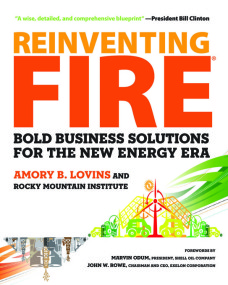The following is a critique, by Ted Trainer, of the energy chapters in Amory Lovins’ new book, Reinventing Fire: Bold Business Solutions for the New Energy Era. Ted is seeking feedback, so please head over to the BNC Discussion forum and leave your comments — on his appraisal, or on your own thoughts of Lovins’ prose.
————-
 A note on the energy chapters in, A. Lovins, Reinventing Fire, Rocky Mountains Institute, 2011.
A note on the energy chapters in, A. Lovins, Reinventing Fire, Rocky Mountains Institute, 2011.
Ted Trainer, UNSW
This book continues the presentation of the Lovins perspective, essentially the claim that there is great scope for conservation measures and alternative technologies to solve our problems and enable maintenance of rich world economies and lifestyles. He says at least 80% of US power, and possibly all of it can come from renewable energy sources by 2050. My comments refer only to the two energy chapters, one on transport fuel and one on power supply.
I don’t think these chapters add much to his Winning the Oil End Game. More importantly, I regard the arguments as quite unsatisfactory and unconvincing. They are almost all superficial; there is no detail and no derivation of conclusions. The core issues require numerical analyses; they are about whether or not quantities and targets can be achieved but there are few if any explanations of this kind in the energy chapters. The approach is to make vague and generalised claims, support them with a few spectacular examples, and proceed as if this establishes that the practice in question could be implemented everywhere. As Smil (undated) said long ago, Lovin’s style is “… discourse by declaration.” This is disappointing as Lovins has extensive expertise on these issues and it could have been applied here more effectively to clarifying the potential and limits of renewable energy.
Lovins claims huge reductions in energy demand will be achieved by efficiency effort. His renewable scenario actually assumes a 70% reduction on the level of electricity demand he says that business as usual would produce by 2050 (from 6000TWh/y down to 1650 TWh/y.) I can’t find any evidence or reasoning supporting this claim in the book. There is much discussion of energy reducing technologies, but no case that these would add to the claimed reduction.
Regarding the difference conservation etc. might make, the estimates I am aware of for the rich countries indicate in recent years a business as usual demand trend rising to about twice the present level by 2050. (Demand is down at present, partly due to the GFC.) Clear and confident estimates of future efficiency gains do not seem to exist, understandably, but for working purposes I assume a 33% reduction to the level business as usual would generate. Note that US population is rising significantly (.91% p.a.) and at this rate would be 50% higher by 2050, so Lovins is actually assuming a very big reduction in energy consumption per capita by 2050.
Smil is one among many who stress the huge gulf that typically exists between what is technically/theoretically possible on the laboratory bench and what is likely to be achieved in the real world. In my critical discussion of the “Tech-fix” position (Trainer, 2012a) I set out the cascade through what might be a) “theoretically possible” without consideration of limiting factors, b) technically possible given real-world difficulties, c) economically possible, e.g., in view of the infinite cost of being as efficient as is possible, d) has an acceptable EROI, e) is socially acceptable, and f) is the final achievement after the Jevons or rebound effect has operated (e.g. where increased car efficiency results in an increase in driving and fuel use.) A good example is where Smeets and Faaij (2007) conclude that global biomass production potential is 1,550 EJ/y, but Field, Lobell and Campbell (2007) conclude that the amount that might be obtained after taking into account all limiting factors would be a mere 27 EJ/y. I don’t think there is any reference in Lovins’ two energy chapters to any of these factors, or even to the EROI concept.
Lovins always has an enthusiastically optimistic view of probable future trends in costs. However discussion of all issues to do with energy, resources, technology, environment and consumption should be based on the assumption that in the near future there are very likely to be large and irreversible rises in the prices of energy, resources, materials, construction, plant and technology etc. These will multiply through the whole economy, impacting further on the construction of new energy technologies, cutting into the availability of capital to build them in large quantity, and into the incomes and capital available to pay for energy and efficiency improvements.
Costs
It is not difficult to show how most or all energy could come from renewables; you just assume enough plant to do it when there is little sun or wind. My main interest is in the capital cost of the energy technologies required to enable demand to be met at all times, and my general view is that renewable energy will be much too capital costly to run consumer societies. (The best current statement of the case is Trainer, 2012b, and as applied to Australia, 2012c.)
Filed under: Emissions, Renewables, Scenarios | 3 Comments »






.png)





